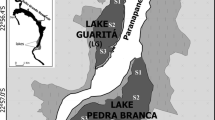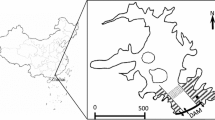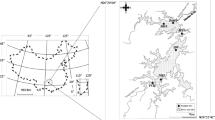Abstract
In aquatic ecosystems, physical disturbances have been suggested to be one of the main factors influencing phytoplankton structure and diversity. To elucidate whether large-scale artificial operation of a hydroelectric reservoir has potential impacts on phytoplankton diversity, the impact on phytoplankton biodiversity of physical disturbances under artificial operation from May 2007 to April 2008 in tributaries of the Three Gorges Reservoir (TGR), China, was analysed. Two disturbance parameters, i.e. the absolute incremental rates of discharge (R d,i ) and precipitation (R p,i ), were created in this study for evaluating physical disturbance intensities during low and high water level periods of the TGR. Results showed that river discharge seemed to be the main factor controlling the phytoplankton diversity in low water level periods (≤151 m), and that precipitation was a potential promoter of the physical disturbance. During the 156-m impoundment process, the species diversity clearly decreased due to the high dilution effect on the phytoplankton communities. At high water level periods (>151 m), the low levels of disturbance eventually allowed the phytoplankton community to approach competitive exclusion in late February 2008. Sharply declining diversity values appeared when the Dinophyta blooms occurred in late March and late April 2008 (Peridinium and Ceratium, respectively).







Similar content being viewed by others
References
Ács, É. & K. T. Kiss, 1993. Effects of the water discharge on periphyton abundance and diversity in a large river (River Danube, Hungary). Hydrobiologia 249: 125–133.
Bain, M. B., J. T. Finn & H. E. Booke, 1988. Streamflow regulation and fish community structure. Ecology 69: 382–392.
Barbiero, R. P., W. F. James & J. W. Barko, 1999. The effects of disturbance events on phytoplankton community structure in a small temperate reservoir. Freshwater Biology 42: 503–512.
Becker, V., V. L. M. Huszar & L. O. Crossetti, 2009. Responses of phytoplankton functional groups to the mixing regime in a deep subtropical reservoir. Hydrobiologia 628: 137–151.
Bertrand, C., V. Siauve, S. Fayolle & A. Cazaubon, 2001. Effects of hydrological regime on the drift algae in a regulated Mediterranean river (River Verdon, southeastern France). Regulated Rivers: Research & Management 17: 407–416.
Bertrand, C., S. Fayolle, E. Franquet & A. Cazaubon, 2003. Responses of the planktonic diatom Asterionella formosa Hassall to abiotic environmental factors in a reservoir complex (south-eastern France). Hydrobiologia 501: 45–58.
Beyruth, Z., 2000. Periodic disturbances, trophic gradient and phytoplankton characteristics related to cyanobacterial growth in Guarapiranga Reservoir, São Paulo State, Brazil. Hydrobiologia 424: 51–65.
Cabecinha, E., P. J. Van, J. A. den Brink, R. Cabral, M. Cortes, M. Lourenco & M. Pardal, 2009. Ecological relationships between phytoplankton communities and different spatial scales in European reservoirs: implications at catchment level monitoring programmes. Hydrobiologia 628: 27–45.
Canion, A. K. & C. Ochs, 2005. The population dynamics of freshwater armored dinoflagellates in a small lake in Mississippi. Journal of Freshwater Ecology 20: 617–626.
Carvajal-Chitty, H. I., 1993. Some notes about the intermediate disturbance hypothesis and its effects on the phytoplankton of the middle Orinoco River. Hydrobiologia 249: 117–124.
Centis, B., M. Tolotti & N. Salmaso, 2010. Structure of the diatom community of the River Adige (North-Eastern Italy) along a hydrological gradient. Hydrobiologia 639: 37–42.
Connell, J., 1978. Diversity in tropical rain forests and coral reefs. Science 199: 1302–1310.
Davis, S. R., A. G. Brown & M. H. Dinnin, 2007. Floodplain connectivity, disturbance and change: a palaeoentomological investigation of floodplain ecology from south-west England. Journal of Animal Ecology 76: 276–288.
Descy, J. P., 1993. Ecology of the phytoplankton of the River Moselle: effects of disturbances on community structure and diversity. Hydrobiologia 249: 111–116.
Donk, E. & D. O. Hessen, 1993. Grazing resistance in nutrient-stressed phytoplankton. Oecologia 93: 508–511.
Fang, F., H. Zhou, Z. Li, M. Long, J. Guo & J. Sheng, 2010. Spatiotemporal variations of euphotic depth and its causing factors in Xiaojiang River backwater area of Three Gorges. Advances in Water Science 21: 113–119.
Figueredo, C. C. & A. Giani, 2001. Seasonal variation in the diversity and species richness of phytoplankton in a tropical eutrophic reservoir. Hydrobiologia 445: 165–174.
Gosselain, V., J. P. Descy & E. Everbecq, 1994. The phytoplankton community of the River Meuse, Belgium: seasonal dynamics (year 1992) and the possible incidence of zooplankton grazing. Hydrobiologia 289: 179–191.
Gruberts, D., I. Druvietis, E. Parele, J. Paidere, A. Poppels, J. Prieditis & A. Skute, 2007. Impact of hydrology on aquatic communities of floodplain lakes along the Daugava River (Latvia). Hydrobiologia 196: 223–237.
Guo, J., C. Zhang, F. Fang, Z. Li, J. Chen & G. Tian, 2008. Study on features of phytoplankton community in Xiaojiang River backwater area in Three Gorges Reservoir during spring and summer time. Science & Technology Review 26: 70–75.
Ha, K., H. W. Kim & G. J. Joo, 1998. The phytoplankton succession in the lower part of hypertrophic Nakdong River (Mulgum), South Korea. Hydrobiologia 369–370: 217–227.
Harris, G. P., 1986. Phytoplankton Ecology: Structure, Function and Fluctuation. Chapman and Hall, London.
Hart, R. C. & P. D. Wragg, 2009. Recent blooms of the dinoflagellate Ceratium in Albert Falls Dam (KZN): history, causes, spatial features and impacts on a reservoir ecosystem and its zooplankton. Water SA 35: 455–468.
Hart, D. D., T. E. Johnson, K. L. Bushaw-Newton, R. J. Horwitz, A. T. Bednarek, D. F. Charles, D. A. Kreeger & D. J. Velinsky, 2002. Dam removal: challenges and opportunities for ecological research and river restoration. BioScience 52: 669–682.
Heise, H. A., 1949. Symptoms of hay fever caused by algae. Journal of Allergy 20: 383–385.
Hu, Z. & Q. Cai, 2006. Preliminary report on aquatic ecosystem dynamics of the Three Gorges Reservoir before and after impoundment. Acta Hydrobiologica Sinica 30: 1–6.
Hu, H. & Y. Wei, 2006. The Freshwater Algae of China: Systematics, Taxonomy and Ecology. Science Press, Beijing.
Humborg, C., V. Ittekkot, A. Cociasu & B. Bodungen, 1997. Effect of Danube River dam on Black Sea biogeochemistry and ecosystem structure. Nature 386: 385–388.
Huszar, V. L. M. & C. S. Reynolds, 1997. Phytoplankton periodicity and sequences of dominance in an Amazonian flood-plain lake (Lago Batata, Pará, Brasil): responses to gradual environmental change. Hydrobiologia 346: 169–181.
Jacobsen, B. A. & P. Simonsen, 1993. Disturbance events affecting phytoplankton biomass, composition and species diversity in a shallow, eutrophic, temperate lake. Hydrobiologia 249: 9–14.
Jeong, K. S., D. K. Kim & G. J. Joo, 2007. Delayed influence of dam storage and discharge on the determination of seasonal proliferations of Microcystis aeruginosa and Stephanodiscus hantzschii in a regulated river system of the lower Nakdong River (South Korea). Water Research 41: 1269–1279.
Jones, R. I. & R. J. Barrington, 1985. A study of the suspended algae in the River Derwent, Derbyshire, UK. Hydrobiologia 128: 255–264.
Kelly, V. J., 2001. Influence of reservoirs on solute transport: a regional-scale approach. Hydrological Processes 15: 1227–1249.
Kimbro, D. L. & E. D. Grosholz, 2006. Disturbance influences oyster community richness and evenness, but not diversity. Ecology 87: 2378–2388.
Kishimoto, N., Y. Ohnishi, I. Somiya & M. Ohnishi, 2001. Behavior of Peridinium bipes (Dinophyceae) resting cysts in the Asahi Reservoir. Limnology 2: 101–109.
Krebs, C. J., 1999. Ecological Methods. Benjamin Cummings, Menlo Park, CA.
Kuang, Q., Y. Bi, G. Zhou, Q. Cai & Z. Hu, 2005. Study on the phytoplankton in the Three Gorges Reservoir before and after sluice and the protection of water quality. Acta Hydrobiologica Sinica 29: 353–358.
Li, Z., F. Fang, J. Guo, J. Chen, C. Zhang & G. Tian, 2009a. Spring algal bloom and nutrients characteristics in Xiaojiang River backwater area, Three Gorge Reservoir, 2007. Journal of Lake Sciences 21: 36–44.
Li, Z., J. Guo, M. Long, F. Fang, J. Sheng & H. Zhou, 2009b. Seasonal variation of nitrogen and phosphorus in Xiaojiang River—a tributary of the Three Gorges Reservoir. Frontiers of Environmental Science & Engineering in China 3: 334–340.
Li, Z., J. Guo, F. Fang, X. Gao, J. Sheng, H. Zhou & M. Long, 2010. Seasonal variation of cyanobacteria and its potential relationship with key environmental factors in Xiaojiang backwater area, Three Gorges Reservoir. Huan Jing Ke Xue 31: 301–309.
Li, Z., J. Guo, F. Fang, M. Long, Z. Liu & X. Gao, 2012. A HEC-RAS based 1D hydrodynamic model on Pengxi (Xiaojiang) River Backwater Area in the Three Gorges Reservoir. Journal of Chongqing University (in press).
Long, T., L. Wu, L. Liu & C. Li, 2009. The simulation of adsorbed phosphorus pollution load based on GIS and the theory of blind number in Xiaojiang River watershed. Journal of Agro-Environment Science 28: 1880–1887.
Lopes, M. R. M., C. Ferragut & C. E. M. Bicudo, 2009. Phytoplankton diversity and strategies in regard to physical disturbances in a shallow, oligotrophic, tropical reservoir in Southeast Brazil. Limnetica 28: 159–174.
Magilligan, F. J. & K. H. Nislow, 2005. Changes in hydrologic regime by dams. Geomorphology 71: 61–78.
Margalef, R., 1975. Perspectives in Ecological Theory. University of Chicago Press, Chicago.
Meng, C. & B. Zhao, 2007. Study on the trend of eutrophication after impounding in Three Gorges Reservoir. Journal of Agro-Environment Science 26: 863–867.
Mihaljević, M., F. Stević, J. Horvatić & B. H. Kutuzović, 2009. Dual impact of the flood pulses on the phytoplankton assemblages in a Danubian floodplain lake (Kopački Rit Nature Park, Croatia). Hydrobiologia 618: 77–88.
Montagnes, D. J. S., J. A. Berges, P. J. Harrison & F. Taylor, 1994. Estimating carbon, nitrogen, protein, and chlorophyll a from volume in marine phytoplankton. Limnology and Oceanography 39: 1044–1060.
Muylaert, K., V. J. Wichelen, K. Sabbe & W. Vyverman, 1999. Chapter 7. Irregular flushing events regulate phytoplankton dynamics in a freshwater tidal estuary. In Distribution and dynamics of protist communities in a freshwater tidal estuary. PhD dissertation, University of Gent, Gent, Belgium.
Nhiwatiwa, T. & B. E. Marshall, 2007. Water quality and plankton dynamics in two small dams in Zimbabwe. African Journal of Aquatic Science 32: 139–151.
Padisák, J., 1993. The influence of different disturbance frequencies on the species richness, diversity and equitability of phytoplankton in shallow lakes. Hydrobiologia 249: 135–156.
Padisák, J., 1994. Identification of relevant time-scales in non-equilibrium community dynamics: conclusions from phytoplankton surveys. New Zealand Journal of Ecology 18: 169–176.
Padisák, J. & C. S. Reynolds, 1998. Selection of phytoplankton associations in Lake Balaton, Hungary, in response to eutrophication and restoration measures, with special reference to the cyanoprokaryotes. Hydrobiologia 384: 41–53.
Paidere, J., D. Gruberts, A. Škute & I. Druvietis, 2007. Impact of two different flood pulses on planktonic communities of the largest floodplain lakes of the Daugava River (Latvia). Hydrobiologia 592: 303–314.
Pannard, A., M. Bormans & Y. Lagadeuc, 2008. Phytoplankton species turnover controlled by physical forcing at different time scales. Canadian Journal of Fisheries and Aquatic Sciences 65: 47–60.
Pielou, E. C., 1966. The measurement of diversity in different types of biological collections. Journal of Theoretical Biology 13: 131–144.
Poff, N. L. & J. V. Ward, 1989. Implications of streamflow variability and predictability for lotic community structure: a regional analysis of streamflow patterns. Canadian Journal of Fisheries and Aquatic Sciences 46: 1805–1818.
Pringle, C., 2003. What is hydrologic connectivity and why is it ecologically important? Hydrological Processes 17: 2685–2689.
Reynolds, C. S., J. Padisák & U. Sommer, 1993. Intermediate disturbance in the ecology of phytoplankton and the maintenance of species diversity: a synthesis. Hydrobiologia 249: 183–188.
Scrosati, R. & C. Heaven, 2007. Spatial trends in community richness, diversity, and evenness across rocky intertidal environmental stress gradients in eastern Canada. Marine Ecology Progress Series 342: 1–14.
Shannon, C. E. & W. Weaver, 1949. The Mathematical Theory of Information, Vol. 97. University of Illinois Press, Urbana: 111–128.
Sommer, U., J. Padisák, C. Reynolds & P. Juhász-Nagy, 1993. Hutchinson’s heritage: the diversity–disturbance relationship in phytoplankton. Hydrobiologia 249: 1–7.
Strathmann, R. R., 1967. Estimating the organic carbon content of phytoplankton from cell volume or plasma volume. Limnology and Oceanography 12: 411–418.
Suzuki, Y. & M. Takahashi, 1995. Growth responses of several diatom species isolated from various environments to temperature. Journal of Phycology 31: 880–888.
Train, S. & L. C. Rodrigues, 1997. Temporal fluctuations of the phytoplankton community of the Baía River, in the upper Paraná River floodplain, Mato Grosso do Sul, Brazil. Hydrobiologia 361: 125–134.
Utermöhl, H., 1958. Zur vervollkommnung der quatitativen phytoplankton-methodik. Mitteilungen-Internationale Vereinigung Für Theoretische und Angewandte Limnologie 9: 1–38.
Venrick, E. L., 1978. How many cells to count? In Sournia, A. (ed.), Phytoplankton Manual. UNESCO, Paris: 167–180.
Weithoff, G., 2003. The concepts of ‘plant functional types’ and ‘functional diversity’ in lake phytoplankton – a new understanding of phytoplankton ecology? Freshwater Biology 48: 1669–1675.
Wu, J., J. Huang, X. Han, Z. Xie & X. Gao, 2003. Three-Gorges Dam – experiment in habitat fragmentation? Science 300: 1239–1240.
Wu, L., T. Long & C. Li, 2010. The simulation research of dissolved nitrogen and phosphorus non-point source pollution in Xiao-Jiang watershed of Three Gorges Reservoir area. Water Science and Technology 61: 1601–1616.
Zeng, H., L. Song, Z. Yu & H. Chen, 2006. Distribution of phytoplankton in the Three-Gorge Reservoir during rainy and dry seasons. Science of the Total Environment 367: 999–1009.
Zhang, Z. & X. Huang, 1991. Research Methods for Freshwater Plankton. Science Press, Beijing: 335–348.
Zhang, C., J. Guo, Z. Li, Q. Pu, F. Fang, M. Long & X. Gao, 2010. Seasonal variation of transparency and its regulating factors in the Xiaojiang backwater area, Three Gorges Reservoir. Journal of Lake Sciences 22: 189–194.
Acknowledgments
This work was supported by the National Critical Patented Projects on Water Pollution Control and Management Program (Program No. 2009ZX07104), the National Natural Science Foundation (Program No. 51009155) and the Fundamental Research Funds for the Central Universities (Program No. CDJXS10211153).
Author information
Authors and Affiliations
Corresponding author
Additional information
Handling editor: Judit Padisak
Rights and permissions
About this article
Cite this article
Li, Z., Wang, S., Guo, J. et al. Responses of phytoplankton diversity to physical disturbance under manual operation in a large reservoir, China. Hydrobiologia 684, 45–56 (2012). https://doi.org/10.1007/s10750-011-0963-2
Received:
Revised:
Accepted:
Published:
Issue Date:
DOI: https://doi.org/10.1007/s10750-011-0963-2




